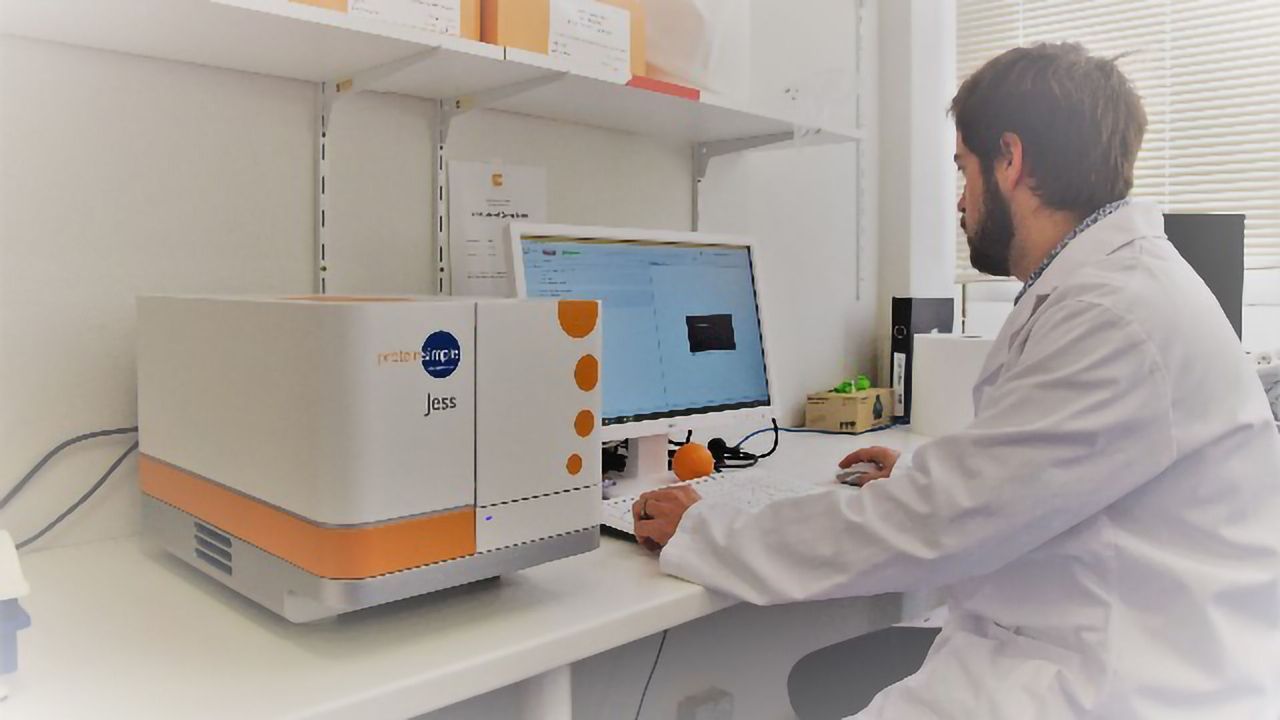
蛋白质印迹的自动化年龄

蛋白质印迹的自动化年龄
Karen Steward (KS): How do the automated western blot systems Wes and Jess differ to traditional manual western blotting?
Alexandre Lucas (AL): Classic western blotting is a method that has changed little over the past 30 years, with the exception of the advent of the charge-coupled device (CCD) camera replacing autoradiographic film. The arrival of the automated capillary western is a real technological leap.
In fact, this method differs little in principle as we retain the three major key steps of western blotting: separation, immobilization/transfer and immunorevelation. But since these steps are automated, we gain in reproducibility and the availability of time to the user. In addition, the passage through the capillaries can significantly reduce the amount of sample required.
KS: Can antibodies used in traditional systems be used for the automated systems, or are specialist reagents required?
AL: Yes, without any problem. Of the 200 antibodies we had to develop on the platform over the past 3 years, only 10% of these antibodies could not be transferred.
We work with all existing antibody suppliers without restriction. The flexibility of the device across all reagents allows us to optimize each step very efficiently. There is a big community database available with all the antibodies validated by the users. We don’t need any specialist reagents. This is one of the huge advantages of this technology, everything is open and customizable!
KS: Traditional western blots often require a lot of optimization to produce a good quality blot. Is this the same case for automated western blot systems, such as Jess?
AL: As with traditional western blots, if you want a high-quality quantification, you need to optimize. The major thing is you can test many conditions to obtain good linearity and saturation conditions in only 1 run of 25 capillaries in 3 hours.
You can’t test so many different conditions in a traditional western blot and on many occasions, those who use our facility re-learn the meaning of “gold standards” when it comes western blot quantification, with Jess.
KS: How has automated western blotting helped your research? Can you please tell us about any specific areas in which this technology has facilitated work that was not otherwise possible?
AL: Jess has made it possible to completely rethink the western blot within the institute, but also for the various start-ups in the Toulouse region. It has helped us in many projects in cardiology, neuroscience, metabolism and even cosmetology. The reproducibility, the small amount of material required and its flexibility have enabled us to carry out large-scale clinical studies or even to produce a western blot on a protein of 1 kDa to 440 kDa.
Dr Alexandre Lucas was speaking to Dr Karen Steward, Senior Science Writer for Technology Networks.
填写下面的表格,我们将向您发送PDF版本的电子邮件“ Western印迹的自动化年龄”
多年来,蛋白质印迹一直是分子生物学的核心技术。但是,由于该技术的性质,协议可能需要费力的优化,即使这样,结果也可能是高度可变的。在追求一致性和可重复性时,诸如此类的问题可能是研究和进步的重大障碍。
多年来,领先的科学期刊一直在发布新的指导,旨在提高Western印迹中显示的数据的质量和可重复性。随着自动化毛细血管蛋白质印迹的引入,现在这个目标似乎已触及。
在2015年,We-Met功能生物化学设施是在代谢和心血管疾病研究所(I2MC)在图卢兹(Toulouse)的目的是提供有关功能生物化学的最新创新技术和技术支持。特别关注围绕自动蛋白质印迹,均质时间分辨荧光(HTRF)介导的生物标志物发现和细胞代谢的研究的三种主要创新技术。该设施现在拥有80位用户,包括学术和私人研究的合作。
最近,我们很高兴与We-Met设施的创始人兼核心经理Alexandre Lucas博士交谈,以了解Western blotting的自动化自动化的简单WESTERN平台WES和proteInsimple的Jess,他们是一个生物技术品牌,他们在该设施中使用,这些进步在研究方面所带来的改变。
Karen Steward(KS):自动化的Western印迹系统WES和JES与传统手动Western印迹有何不同?
亚历山大·卢卡斯(AL):经典的Western印迹是一种在过去30年中变化不大的方法,除了电荷耦合设备(CCD)摄像头的出现外,取代了放射自显影膜。自动毛细管西方的到来是真正的技术飞跃。
实际上,由于我们保留了蛋白质印迹的三个主要关键步骤:分离,固定/转移和免疫界面,因此这种方法原则上几乎没有什么不同。但是,由于这些步骤是自动化的,因此我们会获得可重复性和用户的时间可用性。另外,通过毛细血管的通过可以显着减少所需的样品量。
KS:传统系统中使用的抗体是否可以用于自动化系统,还是需要专业试剂?
AL:是的,没有任何问题。在过去3年中,我们必须在平台上开发的200种抗体中,只有10%的抗体无法转移。
我们与所有现有抗体供应商合作而无需限制。设备在所有试剂中的灵活性使我们能够非常有效地优化每个步骤。有一个大型社区数据库,其所有抗体由用户验证。我们不需要任何专业试剂。这是这项技术的巨大优势之一,一切都是开放和可定制的!
KS:传统的Western印迹通常需要大量优化才能产生高质量的印迹。这是自动蛋白质印迹系统的同一情况吗?杰西?
AL:与传统的Western印迹一样,如果您想进行高质量的量化,则需要优化。主要是您可以测试许多条件,以在3小时内仅15次25毛细血管中获得良好的线性和饱和条件。
您不能在传统的蛋白质印迹中测试许多不同的条件,在许多情况下,使用我们的设施的人在与杰西(Jess)进行蛋白质印迹量化时重新学习“黄金标准”的含义。
KS:自动化的Western印迹如何帮助您的研究?您能告诉我们该技术促进了其他不可能的工作的任何特定领域吗?
AL:杰西(Jess)使能够完全重新考虑研究所内的蛋白质印迹,也可以为图卢兹地区的各种初创企业进行重新考虑。它在心脏病学,神经科学,新陈代谢甚至美容学的许多项目中为我们提供了帮助。可重复性,所需的少量材料及其灵活性使我们能够进行大规模的临床研究,甚至可以在1 kDa至440 kDa的蛋白质上产生蛋白质印迹。
Alexandre Lucas博士正在与技术网络高级科学作家Karen Steward博士讲话。捷克葡萄牙直播



